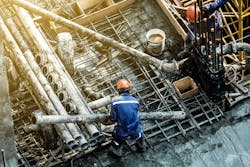ASSP Announces First Standard on Heat Stress in Construction
The American Society of Safety Professionals (ASSP) announced on February 26 that it has published the first national voluntary consensus standard addressing heat stress for workers in construction and demolition operations.
“This new industry consensus standard is an important development because there is no federal regulation focused on heat stress,” said ASSP President Jim Thornton, in a statement. “Employers need expert guidance on how to manage heat-related risks. They must have the tools and resources to identify and help prevent work hazards before an incident occurs.”
ANSI/ASSP A10.50-2024, Heat Stress Management in Construction and Demolition Operations, offers guidance on protecting workers; explains how to acclimate workers to high heat conditions; and provides requirements for training employees and supervisors. The standard contains checklists and flowcharts designed to help companies develop clear and effective heat stress management programs that bridge the regulatory gap.
“There are tens of thousands of heat-related illnesses each year linked to construction and demolition sites, and workers have died from exposures to excessive heat,” said John Johnson, CSP, chair of the ANSI/ASSP A10 standards committee, in a statement. “This new standard outlines industry best practices and proven solutions to protect workers who commonly do strenuous jobs in challenging conditions.”
The A10.50 standard identifies engineering and administrative controls a company can implement to ensure that workers get proper rest, water breaks and shade while still meeting business needs. Recommendations such as medical monitoring and using a buddy system can reduce risks and help prevent heat-related illnesses in many work environments.
While the scope of the standard focuses on construction and demolitions, the guidance can be adapted to protect workers performing other outdoor jobs such as tree trimming, farming, road maintenance and pipeline painting.
The impacts of heat stress can range from mild symptoms such as heat rash and heat cramps to severe conditions including heat exhaustion and heat stroke, which can be fatal. According to the U.S. Bureau of Labor Statistics, more than 400 work-related deaths have been caused by environmental heat exposure since 2011. The standard includes a detailed emergency response plan if a worker has a severe reaction to excessive heat.
The A10.50 subcommittee that wrote the standard consisted of 30 safety and health experts from businesses, trade unions, consulting firms, universities and government agencies. The inclusive process took three years.
Voluntary consensus standards provide the latest expert guidance and fill gaps where federal standards don’t exist. Companies rely on them to drive improvement, injury prevention and sustainability. With government regulations being slow to change and often out of date, federal compliance is not sufficient to protect workers.
ASSP leads the development of voluntary consensus standards for the workplace. In its last fiscal year, ASSP created, reaffirmed or revised 15 standards, technical reports and guidance documents, engaging 1,400 safety experts who represented 500 organizations. The Society also distributed more than 14,000 copies of standards.
About the Author
EHS Today Staff
EHS Today's editorial staff includes:
Dave Blanchard, Editor-in-Chief: During his career Dave has led the editorial management of many of Endeavor Business Media's best-known brands, including IndustryWeek, EHS Today, Material Handling & Logistics, Logistics Today, Supply Chain Technology News, and Business Finance. In addition, he serves as senior content director of the annual Safety Leadership Conference. With over 30 years of B2B media experience, Dave literally wrote the book on supply chain management, Supply Chain Management Best Practices (John Wiley & Sons, 2021), which has been translated into several languages and is currently in its third edition. He is a frequent speaker and moderator at major trade shows and conferences, and has won numerous awards for writing and editing. He is a voting member of the jury of the Logistics Hall of Fame, and is a graduate of Northern Illinois University.
Adrienne Selko, Senior Editor: In addition to her roles with EHS Today and the Safety Leadership Conference, Adrienne is also a senior editor at IndustryWeek and has written about many topics, with her current focus on workforce development strategies. She is also a senior editor at Material Handling & Logistics. Previously she was in corporate communications at a medical manufacturing company as well as a large regional bank. She is the author of Do I Have to Wear Garlic Around My Neck?, which made the Cleveland Plain Dealer's best sellers list.
Nicole Stempak, Managing Editor: Nicole Stempak is managing editor of EHS Today and conference content manager of the Safety Leadership Conference.
